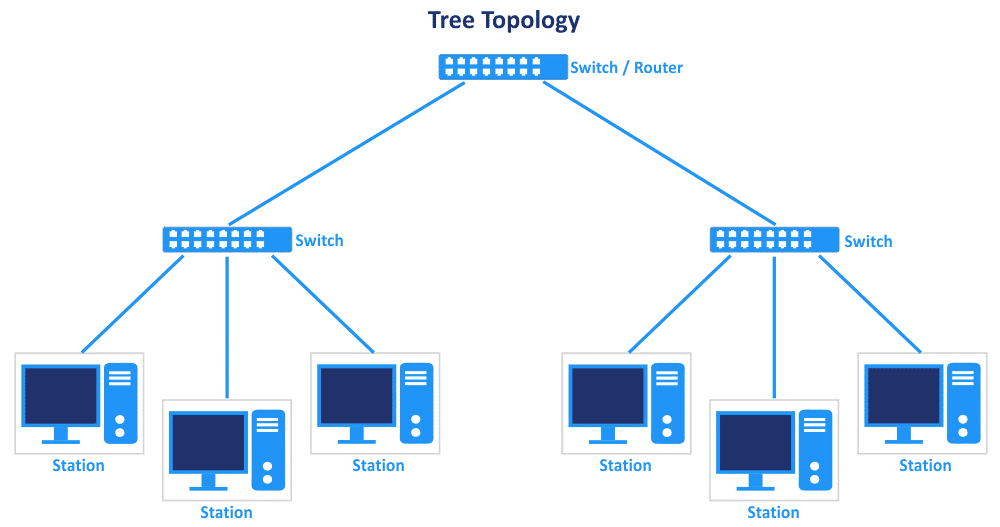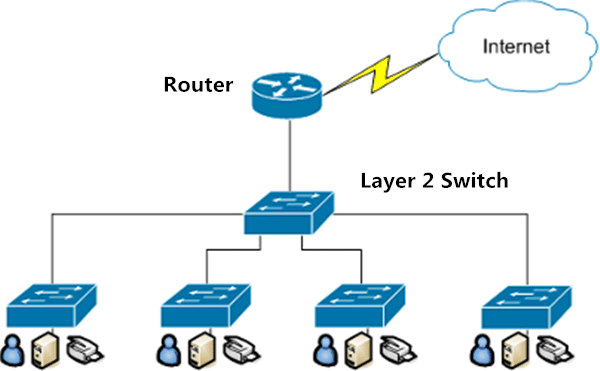Network Switch
It can be said that switches are one of the most widely used pieces of hardware.
A switch is a very small piece to which each system is connected with a network cable. When information is sent from a computer within the network, this device, in addition to management, sends the message to the main destination and actually connects the users' systems.
Application of switches in the network
One of the important advantages of using switches is the connection and communication of systems with each other. Using switches, you can connect a large number of systems.
The switch increases the speed of data transfer on local networks and also controls the amount of network usage. It can be said that switches have a managerial role to control traffic on the network.
You should keep in mind that the more systems you have, the more ports you will have to use.

Types of network switches in terms of speed
- 10/100 Fast Ethernet
- 10/100/1000 Gigabit Ethernet
- 10/100/1000/10000 Gigabit

Types of switches in terms of capability
- Fixed Switch
- Modular Switches
- Stuckable Switch
- PoE Switch
- Fiber Optic Switch
- Unmanaged Switch
- Managed Switch
- Smart Switch or Smart Switch
- Layer 3 Switch
- DataCenter Switch
Fixed Switches
Fixed switches have a certain number of ports and cannot be changed or upgraded, such as 8 ports, 16 ports, and 24 ports. These switches are the most popular type of switch on the market and also have a relatively cheap price.
Modular Switches
Unlike the fixed switch, the modular switch can be expanded and upgraded by adding a module on the case, which means that by adding each module, it is possible to add a port and add a user.
These switches are used in large networks such as data centers and large enterprise networks. Most of these switches also work on the third layer and can be used as routers. These switches have a power plug and several cooling fans in the case.
PoE Switch
It stands for Power over Ethernet and works based on PoE technology.
This switch is one of the types of network switches that transmit electricity and data in a cable. In this type of switch, you can power the devices with a network cable, which provides the necessary electricity to start the devices through an Ethernet cable.
In simpler terms, this device itself is powered by the main power supply and with the help of PoE, and these devices can power other devices that are connected to them, such as cameras and phones.
PoE switches are characterized by high flexibility.
Management Switches
Manageable switches are built on the basis of controllability and through Unix-style command-line interfaces. Regarding such switches, we can mention smart switches, which are often considered by emerging and mid-level companies. These switches, like home routers, support web-based interfaces.
These switches are suitable for users for whom response time is important and should be milliseconds and fast. It is very useful in organizations that need to manage and troubleshoot their networks remotely and protectively. These switches allow network administrators to achieve an optimal and reliable network.
Management switches should be used on networks where traffic is monitored and controlled. Management switches allow for full control of data, bandwidth, and traffic.
Web Smart Switches
Web Smart switches are also known as Smart or Web Managed.
A few of the features of Web smart switches: They have access to manage switches. Monitoring ports offer link aggregation and VPN through a simple web interface by a web browser.
However, a feature these switches typically lack: the ability to manage SNMP or CLI. Web-smart switches generally must be managed individually, not as a group.
Although the management features of web-smart switches are less than those of management switches, nowadays these switches have become smarter and provide us with most of the features that management switches offer.
Layer 3 Switches:
In a simple definition, a layer 3 switch is a combination of a switch and a router. As a switch, it performs the task of communicating between devices that are in a subnet in a fraction of a second. In addition, like routers, it has intelligent IP routing capabilities. Due to this capability, it supports routing protocols, inspects incoming packets, and can even make decisions about packet routing based on the sender's and receiver's addresses. In this way, a layer 3 switch acts as a switch and a router at the same time.

Network switches are capable of supporting all devices and communication devices. For Ethernet devices, they can provide four or eight connections, while switches used in companies can support 32 to 128 connections.
In addition, it is also possible to link and connect the switches to each other. This is done under a method called daisy chaining, whereby more devices and communication devices are added to a LAN.
Stackable Switch
This type of switch is a combination of two switches: Fixed and Modular. The Stackable Switch makes it possible to connect multiple switches from the same model directly to increase capacity and utilization. It should be noted that when you connect multiple Stackable model switches, only one IP address is assigned to the switches and is known as a single switch in the network, and you no longer have to configure each device separately
Full Duplex or Two-Way Switches
Two-way switches are switches that can send and receive information simultaneously.
Fiber Optic Switch
The use of copper cables is not always appropriate. If you use a fiber optic cable, you must also use a fiber optic switch in order to have an integrated system.
With fiber optic cables, you can transmit information up to 120 kilometers, but with copper cables, you can transmit information up to 100 meters.
Fiber optic ports are used to connect switches on the same floor of a building or buildings with distances of several kilometers from each other.
Unmanaged switch
Non-management switches are mostly used in home networks and small enterprises. These switches start working after they are installed, i.e., they are plug and play.
These switches only require cables to communicate, and they have a fixed configuration, meaning that no configuration changes can be made.
Unmanaged switches can only connect devices on a VLAN and only provide layer 2 connectivity.
With non-management switches, Ethernet devices can be easily connected, such as printers, network systems, and Wi-Fi routers.
The main difference between managerial and non-managerial switches is the ability to configure the switch and prioritize LAN traffic so that the most important information is prioritized for sending.





